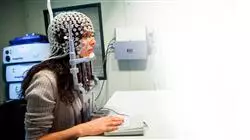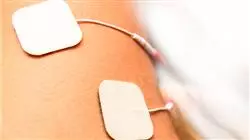University certificate
The world's largest faculty of medicine”
Introduction to the Program
Learn how to treat chronic pain such as fibromyalgia, herniated disc or sciatica and become a highly sought after and renowned practitioner"

Many chronic ailments afflict today's patients. Many of them are related to neurophysiological pathologies, so an approach from this field of knowledge is necessary to treat issues such as epilepsy, OSA or Parkinson's disease, among many others that hinder people's lives.
In addition, intraoperative neurophysiological monitoring has become so important in recent decades that it has even become a legal requirement for many procedures. This is because postoperative diagnostics, as well as the surgical procedures themselves, are greatly benefited by using this technique.
Given the importance of these two fields, it is an interesting avenue for professional growth for all physicians who aspire to increase the level of their careers. Thanks to this TECH Postgraduate diploma, the graduate will have a more complete understanding of therapeutic neurophysiology, its applications in common pathologies in patients and how to use it to monitor surgeries of varying complexity.
This will allow the student not only to access a higher level of knowledge, but even a higher level in his or her professional field. The student even has the convenience of being able to study this course completely online, without the need to attend physical classes or adhere to specific schedules, being able to combine it with daily activities and work.
You will be prepared to make a quality leap in the medical field by adding this Postgraduate diploma in Evoked Potentials, Intraoperative Monitoring and Neurophysiological Techniques for Therapeutic Purposes to your curriculum"
This Postgraduate diploma in Evoked Potentials, Intraoperative Monitoring and Neurophysiological Techniques for Therapeutic Purposes contains the most complete and up to date scientific program on the market. The most important features include:
- The development of case studies presented by physicians with expertise in neurophysiology for therapeutic purposes
- The graphic, schematic, and eminently practical contents with which they are created, provide scientific and practical information on the disciplines that are essential for professional practice
- Practical exercises where self-assessment can be used to improve learning
- Its special emphasis on innovative methodologies
- Theoretical lessons, questions to the expert, debate forums on controversial topics, and individual reflection assignments
- Content that is accessible from any fixed or portable device with an Internet connection
Forget old-fashioned programs that require your total devotion and join TECH's educational future where you are the one who sets the pace of study"
The program’s teaching staff includes professionals from the sector who contribute their work experience to this training program, as well as renowned specialists from leading societies and prestigious universities.
The multimedia content, developed with the latest educational technology, will provide the professional with situated and contextual learning, i.e., a simulated environment that will provide immersive training programmed to train in real situations.
This program is designed around Problem Based Learning, whereby the professional must try to solve the different professional practice situations that arise during the academic year. For this purpose, the student will be assisted by an innovative interactive video system created by renowned and experienced experts.
You will become a more prestigious doctor thanks to the new neurophysiological techniques that you will apply to your patients with more severe pain"

Lay the foundation for a medical future that is more relevant to you by enrolling in this Postgraduate diploma today"
Why study at TECH?
TECH is the world’s largest online university. With an impressive catalog of more than 14,000 university programs available in 11 languages, it is positioned as a leader in employability, with a 99% job placement rate. In addition, it relies on an enormous faculty of more than 6,000 professors of the highest international renown.

Study at the world's largest online university and guarantee your professional success. The future starts at TECH”
The world’s best online university according to FORBES
The prestigious Forbes magazine, specialized in business and finance, has highlighted TECH as “the world's best online university” This is what they have recently stated in an article in their digital edition in which they echo the success story of this institution, “thanks to the academic offer it provides, the selection of its teaching staff, and an innovative learning method aimed at educating the professionals of the future”
A revolutionary study method, a cutting-edge faculty and a practical focus: the key to TECH's success.
The most complete study plans on the university scene
TECH offers the most complete study plans on the university scene, with syllabuses that cover fundamental concepts and, at the same time, the main scientific advances in their specific scientific areas. In addition, these programs are continuously being updated to guarantee students the academic vanguard and the most in-demand professional skills. In this way, the university's qualifications provide its graduates with a significant advantage to propel their careers to success.
TECH offers the most comprehensive and intensive study plans on the current university scene.
A world-class teaching staff
TECH's teaching staff is made up of more than 6,000 professors with the highest international recognition. Professors, researchers and top executives of multinational companies, including Isaiah Covington, performance coach of the Boston Celtics; Magda Romanska, principal investigator at Harvard MetaLAB; Ignacio Wistumba, chairman of the department of translational molecular pathology at MD Anderson Cancer Center; and D.W. Pine, creative director of TIME magazine, among others.
Internationally renowned experts, specialized in different branches of Health, Technology, Communication and Business, form part of the TECH faculty.
A unique learning method
TECH is the first university to use Relearning in all its programs. It is the best online learning methodology, accredited with international teaching quality certifications, provided by prestigious educational agencies. In addition, this disruptive educational model is complemented with the “Case Method”, thereby setting up a unique online teaching strategy. Innovative teaching resources are also implemented, including detailed videos, infographics and interactive summaries.
TECH combines Relearning and the Case Method in all its university programs to guarantee excellent theoretical and practical learning, studying whenever and wherever you want.
The world's largest online university
TECH is the world’s largest online university. We are the largest educational institution, with the best and widest online educational catalog, one hundred percent online and covering the vast majority of areas of knowledge. We offer a large selection of our own degrees and accredited online undergraduate and postgraduate degrees. In total, more than 14,000 university degrees, in eleven different languages, make us the largest educational largest in the world.
TECH has the world's most extensive catalog of academic and official programs, available in more than 11 languages.
Google Premier Partner
The American technology giant has awarded TECH the Google Google Premier Partner badge. This award, which is only available to 3% of the world's companies, highlights the efficient, flexible and tailored experience that this university provides to students. The recognition as a Google Premier Partner not only accredits the maximum rigor, performance and investment in TECH's digital infrastructures, but also places this university as one of the world's leading technology companies.
Google has positioned TECH in the top 3% of the world's most important technology companies by awarding it its Google Premier Partner badge.
The official online university of the NBA
TECH is the official online university of the NBA. Thanks to our agreement with the biggest league in basketball, we offer our students exclusive university programs, as well as a wide variety of educational resources focused on the business of the league and other areas of the sports industry. Each program is made up of a uniquely designed syllabus and features exceptional guest hosts: professionals with a distinguished sports background who will offer their expertise on the most relevant topics.
TECH has been selected by the NBA, the world's top basketball league, as its official online university.
The top-rated university by its students
Students have positioned TECH as the world's top-rated university on the main review websites, with a highest rating of 4.9 out of 5, obtained from more than 1,000 reviews. These results consolidate TECH as the benchmark university institution at an international level, reflecting the excellence and positive impact of its educational model.” reflecting the excellence and positive impact of its educational model.”
TECH is the world’s top-rated university by its students.
Leaders in employability
TECH has managed to become the leading university in employability. 99% of its students obtain jobs in the academic field they have studied, within one year of completing any of the university's programs. A similar number achieve immediate career enhancement. All this thanks to a study methodology that bases its effectiveness on the acquisition of practical skills, which are absolutely necessary for professional development.
99% of TECH graduates find a job within a year of completing their studies.
Postgraduate Diploma in Evoked Potentials, Intraoperative Monitoring and Neurophysiological Techniques for Therapeutic Purposes.
Evoked potentials, intraoperative monitoring and neurophysiological techniques for therapeutic purposes are tools used in veterinary medicine to diagnose and treat a variety of neurological conditions and other diseases. Evoked potentials are techniques for recording the electrical activity of the central nervous system in response to an external stimulus, such as a sound signal or a flash of light. These potentials can be used to diagnose specific neurological disorders, such as epilepsy, myasthenia gravis and optic neuropathy. Intraoperative monitoring is used during surgery to assess and minimize the risk of neurological damage. During spinal or brain surgery, evoked potentials, spontaneous movements and muscle activity can be monitored to detect any changes in the normal functioning of the nervous system. This can help surgeons adjust the course of surgery to avoid neurological injury.
Neurophysiological techniques for therapeutic purposes include transcutaneous electrical nerve stimulation (TENS) and neurological rehabilitation. TENS uses low-frequency electrical currents to stimulate peripheral nerves, relieving pain and improving muscle function and range of motion. Neurological rehabilitation includes exercises and physical therapy designed to help patients regain strength and movement after neurological injury or surgery. Evoked potentials, intraoperative monitoring and neurophysiological techniques for therapeutic purposes are tools used to diagnose and treat a variety of neurological conditions and other diseases. They are advanced tools that can help veterinarians provide more accurate and effective treatments for their patients. TECH, the world's largest digital university, has a specialized academic program designed to provide students with solid skills in neurophysiology and related therapeutic techniques for the prevention, diagnosis, treatment and rehabilitation of neurological disorders. Students will learn to apply advanced neurophysiology techniques to monitor and improve neurological function.







